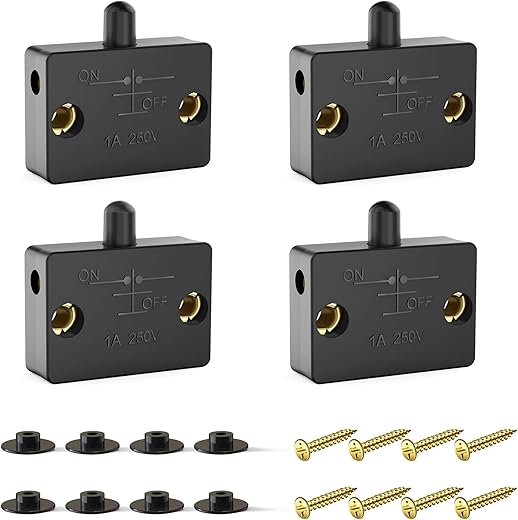









Understanding Door Switches: The Unsung Heroes of Home Automation
When you think of home automation, what comes to mind? Smart thermostats? Automated lights? While those gadgets often steal the spotlight, let’s not overlook the humble yet essential door switch. This small component plays a significant role in enhancing the functionality and security of your home. But what exactly is a door switch, and why should you care? Let’s dive into the fascinating world of door switches and explore their importance and applications.
What is a Door Switch?
At its core, a door switch is a sensor that detects the opening and closing of a door. It can be as simple as a mechanical switch that completes a circuit when the door is closed, or as sophisticated as a magnetic sensor that uses a magnet to trigger a response. Think of it like the doorman of your house, keeping track of who’s coming and going.
Door switches can be used in various applications, from home security systems to automated lighting. When you open your door, the switch sends a signal to your smart home hub, which can then activate different routines, such as turning on lights or sending notifications to your smartphone. It’s like having a personal assistant that knows exactly when you walk through the door.
Types of Door Switches
Just like every door has its unique style, door switches come in various types, each suited for specific applications. Let’s explore some of the most common types:
1. Mechanical Door Switches
Mechanical door switches are the classic workhorses of the door switch family. When you open or close a door, the physical movement activates a spring-loaded mechanism that either completes or breaks an electrical circuit. These switches are often found in older homes or basic security systems. They’re reliable and straightforward but may not offer the latest smart features.
2. Magnetic Door Switches
Magnetic door switches are like the stealthy ninjas of door sensors. They consist of two parts: a magnet and a switch. When the door is closed, the magnet keeps the switch in a closed position. Open the door, and the magnet moves away, causing the switch to open and send a signal. These switches are commonly used in security systems and can be easily installed, making them ideal for those looking to enhance their home security without major renovations.
3. Wireless Door Switches
For those who love the idea of a clutter-free home, wireless door switches are a game-changer. These switches communicate with your smart home system via Wi-Fi or Bluetooth, eliminating the need for extensive wiring. Imagine being able to monitor your home’s entry points from your smartphone while lounging on the couch. That’s the power of wireless door switches!
Why You Should Consider Installing Door Switches
Still not convinced about the importance of door switches? Let’s break down a few compelling reasons to consider installing them in your home.
1. Enhanced Security
Security is a top priority for any homeowner. Door switches can alert you whenever a door opens, giving you peace of mind. Imagine being on vacation and receiving a notification that your front door has been opened. You can quickly check your security cameras or alert the authorities. It’s like having a vigilant guard watching over your home while you’re away.
2. Energy Efficiency
Did you know that door switches can help you save on energy bills? When integrated with smart lighting systems, these switches can automatically turn off lights when you leave a room or home. It’s a small change that can lead to significant savings over time. Think of it as your home’s way of saying, “Let’s save some money!”
3. Convenience
Imagine walking into your home, and as soon as you open the door, the lights turn on, and your favorite music starts playing. This level of convenience is possible with door switches integrated into smart home systems. They create a seamless experience that welcomes you home, much like a friendly hug at the end of a long day.
Installation and Maintenance
Installing a door switch varies depending on the type you choose. Mechanical switches may require basic wiring, while magnetic and wireless switches can often be installed with adhesive pads. Always follow the manufacturer’s instructions for best results.
As for maintenance, door switches are generally low-maintenance. However, keeping them clean and ensuring that the sensors are unobstructed can prevent false alarms and ensure they function optimally.
Conclusion
In the grand scheme of home automation, door switches may not be the flashiest gadgets, but their contribution to security, energy efficiency, and convenience is undeniable. Whether you opt for a mechanical, magnetic, or wireless switch, you’re investing in a smarter, safer home. So, why not take the plunge and consider adding door switches to your home automation arsenal?
After all, every home deserves a vigilant guardian at the door!
FAQs
1. How do I choose the right door switch for my home?
Choosing the right door switch depends on your specific needs. Consider factors like installation type, whether you want a wired or wireless setup, and the compatibility with your existing smart home system.
2. Can I install a door switch myself?
Yes! Many door switches, especially magnetic and wireless options, are designed for easy installation and can typically be set up by homeowners without professional help. Just follow the instructions provided by the manufacturer.
3. What should I do if my door switch triggers false alarms?
If your door switch triggers false alarms, check for obstructions around the sensor, ensure proper alignment, and clean any debris. If issues persist, consult the manufacturer’s troubleshooting guide for further assistance.
